Did you know that there are over 780 species of hollies (genus Ilex) distributed all over the world including parts of North America?
There are no native Ilex in the Pacific Northwest, but after its introduction to the region as an ornamental in the late 1800’s, English holly (Ilex aquifolium) became very popular in gardens due to its attractive evergreen foliage and bright red fruits.
Not-So-Jolly About English Holly
Unfortunately, English holly is now considered by ecologists and land managers to be a noxious weed. Their berries (drupes) and seeds have been widely distributed by birds and studies in the last few decades suggest that the dense, evergreen shrub shades out the understory, and outcompetes native plants in natural areas and PNW forests.
Check out this Think Outloud interview with David Stokes, professor emeritus of ecology and conservation biology at the University of Washington, Bothell to learn about the spread of English holly in the Northwest and what’s being done to combat it.
Alternative Hollies
What can replace English holly as a beloved ornamental? That’s what we hope to discover!
In partnership with the Holly Society of America, Hoyt Arboretum grows sterile cultivars of English holly as well as species and cultivars from gardens all over the world as part of their “Test Holly Program”. The unique species and varieties planted in our Holly Loop are monitored for hardiness, bloom time, growth rate, soil requirements, site exposure, diseases, insect pests, and deer resistance.
Some non-aggressive Ilex aquifolium cultivars:
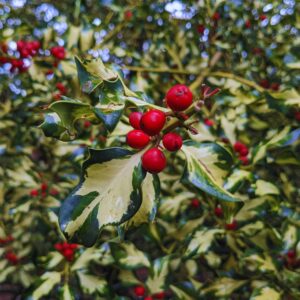

Ilex aquifolium ‘Crinkle Variegated’ is an evergreen tree with densely branched, erect growth suitable for training as a shrub. Its dark green, moderately broad, oval leaves are regularly spined and neatly edged with creamy white variegation. Clusters of red berries appear on short peduncles, following greenish-white flowers in May. This cultivar requires moderate water once established and offers year-round interest in the landscape.
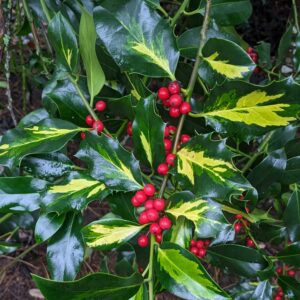

Ilex aquifolium ‘Pinto’IIlex aquifolium ‘Pinto’ is a slow-growing English holly cultivar prized for its striking variegated leaves, which display whitish, yellowish, or spotted margins and central blotches. This evergreen shrub or tree has a pyramidal growth habit, glossy dark green leaves with spiny margins, and bright red berries. It is a hardy cultivar that can tolerate a wide range of soils, and, while it prefers full sun, it can adapt to shady conditions.
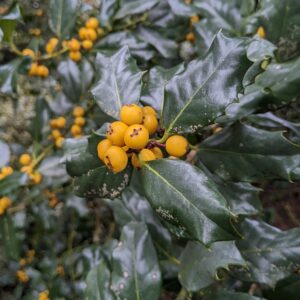

Ilex aquifolium ‘Yellow Berry Curry Co.’ is an unofficial English holly cultivar of garden origin, acquired from Curry County, Oregon. Its foliage consists of the typical spiny, glossy dark green leaves of English holly, paired with bright yellow berries that persist through winter. An evergreen shrub or tree, it features a pyramidal growth habit and can reach up to 50 feet tall and 20 feet wide under ideal conditions. Like other English hollies, it is versatile in the landscape, adapting to various light and soil conditions.
Some unique holly species and cultivars:
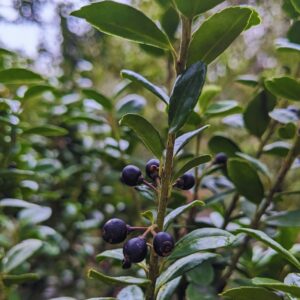

A compact and dense evergreen shrub, Ilex crenata ‘Convexa’ is a cultivar of a holly native to eastern China, Japan, Korea, Taiwan, and Sakhalin. It is a Great Plant Pick for its fast growth and durability, quickly reaching the desired height of 5-6 feet and equal width. IIts leaves are dark green and have a unique convex, or curved shape. Females set heavily with dark blue to black berries.
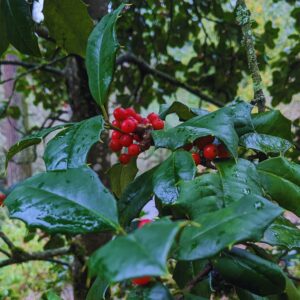

A truly “American holly”, Ilex opaca is native to eastern and south-central United States. This cultivar, Ilex opaca ‘Ruth’ is a dioecious evergreen that can grow very large, reaching up to 90 feet tall in ideal conditions. Leaves are dense, dark green, and leathery with spine-tipped serration. Small and greenish-white flowers bloom in the spring, and bright red berries ripen in fall and persist through winter.
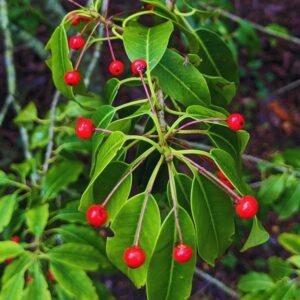

Ilex pedunculosa is a unique holly species with its long, ovate evergreen foliage and long peduncles,or stalks that bear its bright red fruit. Native to central and southern China, Taiwan, and Japan, this holly grows into a lanky shrub or shrubby tree typically reaching 16 feet.
Explore the Holly Loop at Hoyt Arboretum
There are many alternative hollies and non-aggressive cultivars planted along the Holly Loop at Hoyt Arboretum. You’ll see incredible diversity in form, leaf shape & color, drupe (fruit) color. Great for a short winter walk, but also great options for gardens and landscaping projects of your own. Make sure to ask your local nurseries for these illustrious Ilex — if they don’t have it now, creating demand is part of the process for phasing out English holly for something better!
Explore the diversity of Hoyt Arboretum’s Holly Loop through the ‘Tours function in our Plant Database. Click HERE and select ‘Holly Loop Tour’ from the dropdown menu.
The beginning of the Holly Loop is located at the southeast corner of the main parking area adjacent to the Visitor Center. Access it via the steps to the right of the beginning of the Overlook Trail (labeled with a green 2 on our Trail Map).
